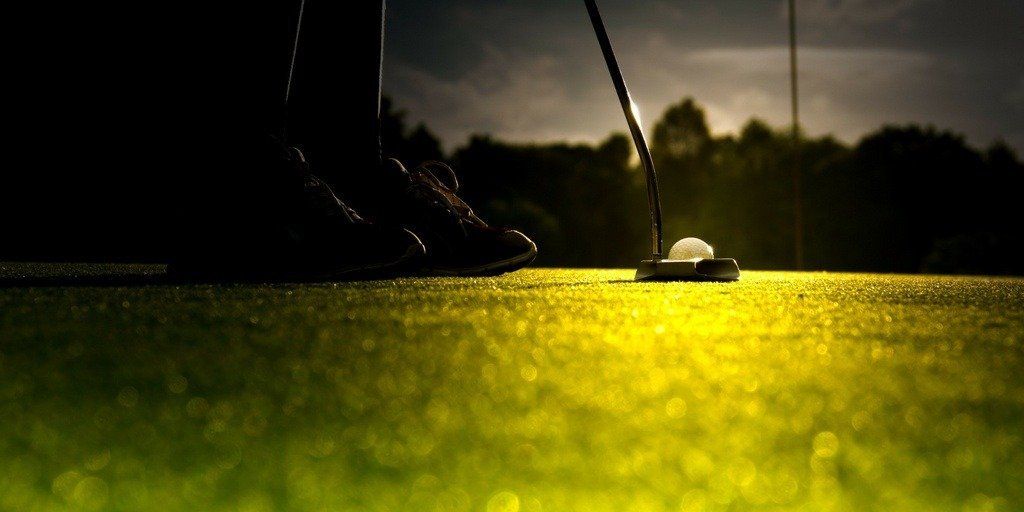
Are you needlessly throwing away strokes on the putting green? Frustrated with your putter?
I've got help for you! In this guide, I have combined all of the best putting tips I have learned over the years.
We'll cover:
- Managing expectations
- Speed control
- The putting stroke
- Green reading strategies
- Putting drills
- Products that can help
- and much more
There is a lot of helpful information in this guide, and it's not meant for you to try everything at once. My best advice is to choose one or two concepts to work on at a time.
Let's get into it!
Manage Your Expectations Properly
A large part of becoming a successful putter is having the right attitude. Most golfers struggle on the greens because their expectations are way out of line. This causes undue stress and disappointment that bleeds over into other parts of your game.
All golfers would agree that putting is difficult. However, the majority of recreational players don't understand just how hard it truly is.
The easiest way to clear things up sometimes is to share what is actually happening with players of different levels. Take a look at these stats from Mark Broadie's book Every Shot Counts:

You can see that as you move farther away from the hole the chances of making a putt fall dramatically for all levels of golfers. As you would expect, PGA Tour players fare much better, but they are still only making half of their putts from 8 feet away.
There are a few takeaways I would like to highlight, which will shape the advice given in this guide:
- Your expectations of making putts are likely way too high. Don't be so hard on yourself!
- Recreational golfers' best chances of holing out putts occur within 10 feet.
- Once you get outside of that range, your main focus should be keeping your second putt as close to the hole as possible to avoid three putts.
To make a long story short - your realistic goal as a golfer is to make more putts inside of 10 feet and improve your proximity to the hole on putts outside of this distance.
The rest of the article will be focused on helping you achieve those two goals.
Speed Control: The Glue That Holds Everything Together
If you want to improve at putting, you have to improve your speed control on the greens. There is simply no way around this.
Speed affects everything. You can make a great read, but if your speed is off you have no chance of making the putt. Some people only think it's important on longer putts (it is), but it can be even more important on those shorter putts inside of 10 feet. If there is one thing I want you to learn from this article, it is that hitting putts harder in order to make them does not work.
In fact, you're actually making it harder for yourself because you make the hole smaller. Take a few minutes to watch this video, I believe it will save you multiple shots on the course:
Controlling your speed on the greens will help you achieve the two goals of making shorter putts, and improving your proximity to the hole on longer ones.
How Do You Improve Your Speed Control?
OK, if you believe me that speed control is important you probably want to know how to improve your skills. The thing about speed (and other feel shots in the short game) is that it has to be earned. You can't simply decide to read some books, watch some videos, and improve your performance.
It has to be earned through smart practice and playing more
You can't expect to improve in this part of putting unless you spend the time during practice sessions, and actually play more golf. Luckily, it doesn't require a ton of time compared to improving your full swing. Here are a couple of drills that can help:
Products That Can Help With Speed Control
There are two elements of controlling your speed on the greens:
- Controlling the length and rhythm of your stroke
- Striking the ball more consistently towards the center of the face
I have tested a bunch of products and believe there are two in particular that can help in this area.
Blast Motion is an excellent tool for putting in general, but it thrives when it comes to the timing and length of your stroke. You can read my full review here.
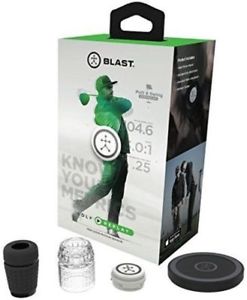
Another great tool is TIBA Putt. It is a better version of the popular two-tee drill that Tiger Woods uses. This is a great putting aid for your stroke in general, but it will certainly help you get a more consistent strike on the putter face. You can read my full review here.
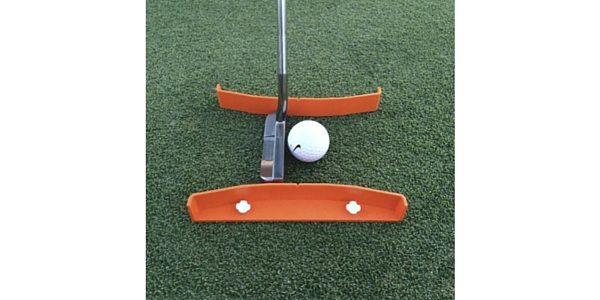
Controlling Your Putting Stroke: Squaring the Face
Let me first start off by saying there is no correct putting stroke for all golfers. There have been plenty of variations that have produced success. However, one thing that all great putters have in common is that they can start the ball on their intended line very well.
When it comes to the putting stroke it is important to understand that the direction of the putter face at impact will mostly determine where the ball is headed. In other words, if the putter face is slightly closed, the ball will travel to the left, and vice versa if it is open. The path of the putter will have a large effect on how well you can square the face at impact.
All putting strokes have some form of an arc in them. Contrary to popular belief there is no such thing as a truly straight back, and straight through stroke. How much of an arc depends on the golfer, but a successful stroke will allow the putter face to square the face to a golfer's intended target at impact.
So how do you produce a nicely arcing putting stroke that starts the ball on your intended line? Let's discuss...
Putting Drills to Square the Face
Here is a great drill you can perform with two alignment sticks from our Insider Member Video Library:
Another tool that you'll see PGA Tour players using to help with their putting strokes are putting mirrors. There are plenty of them out there, but I recommend this one from Eyeline golf. This will also help with your posture and setup.
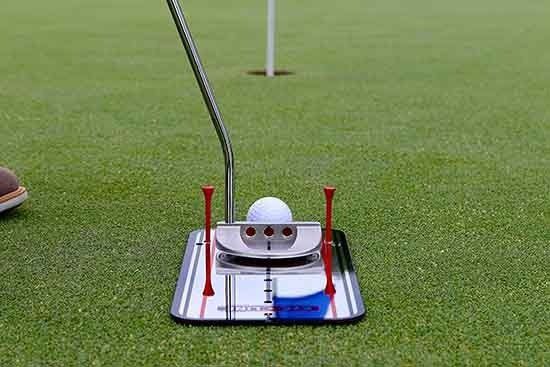
As mentioned earlier, another great tool is the TIBA Putt.
Reading The Greens Properly
It's very difficult to make putts unless you are skilled at reading the greens. You don't have to get the read exactly right, but you certainly want to get the direction of the putt correct at the minimum. In turn, it will help you make more of those putts inside 10 feet, and keep the ball closer to the hole on longer putts.
There are so many myths when it comes to green reading. When people start talking about how all putts mysteriously break to a singular point on the course, stop listening to them! The golf ball simply reacts to gravity, and you need to be able to determine the slope of a green with relative accuracy.
There are two basic tips that I believe can help most golfers improve their green-reading skills.
The first comes from Dave Stockton's wonderful book on putting. If you are going to evaluate the slope of a putt with your eyes it's better to read the putt from the lower side. It is much easier to identify the slope from this angle. Think of it like how you read a book. It would be much harder to see the text clearly if it was pointed away from you on a downward angle.
Next, I want to discuss something that has become very influential in my own green reading - my feet.
AimPoint Golf
A couple of years ago I learned AimPoint Express, which is a green-reading system that has you measure the slope of putts with your feet. You may have seen several professional players holding up their fingers when they putt on TV, which means they are using this system.
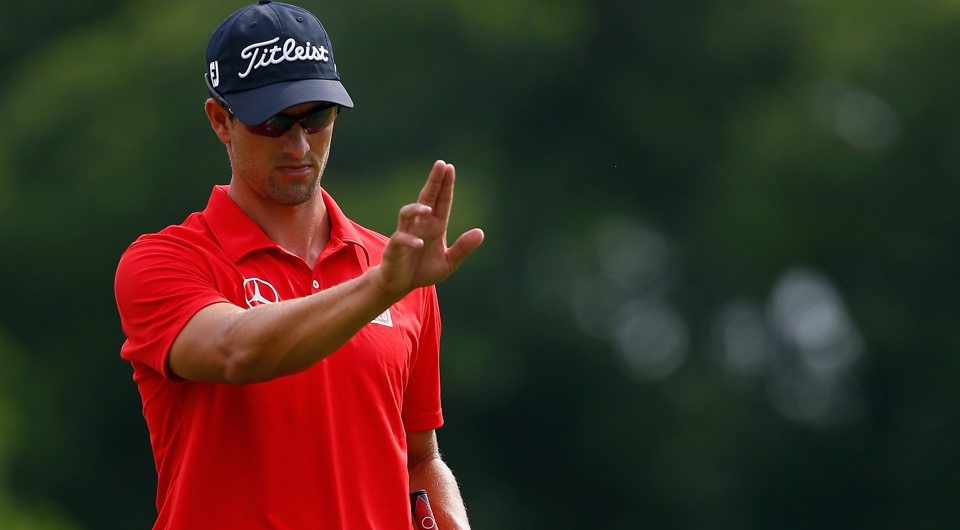
Overall, I have found using my feet to be far more accurate at determining the slope of a putt than my eyes. In fact, I would say that on the whole, your eyes will play far more "tricks" on you than your feet will.
If you are interested in learning more about AimPoint you can read this article I wrote. I would recommend it to any level of golfer out there because it's easy to learn, effective, and takes a lot of the guesswork out of putting.
Even if you don't go to an AimPoint clinic or watch their DVD, start experimenting with using your feet to read the direction of putts. Close your eyes and feel where gravity is pulling you. I can almost guarantee you that the quality of your reads will increase.
Grip Technique & Style
In recent years there has been an explosion of golfers trying alternate putting-grip techniques products. All you have to do is watch a PGA Tour event and you'll see players putting cross-handed, with a claw grip, or some other kind of modification. The conventional putting grip has not gone out the window, but there is an opportunity for many golfers to fix flaws in their technique by either changing the way they grip the putter with their hands or the actual grip itself.
I'll explore both topics to show how you can experiment with changes.
Grip Technique
Louis Oosthuizen had some interesting words on putting-grip technique:
My putting strategy is simple. If you're not making putts, don't be afraid to change your technique.
So what are your options? Here is a rundown of several methods to grip the putter and how they can help:
Reverse Overlap - The Traditional Method

Most players are used to this grip. You take the conventional Vardon style of full swing and modify it so that your left forefinger rests on top of the fingers of your right hand.
This was the accepted standard and it was seldom questioned. Many top players today still use this grip. However, this might not be the right putting grip style for you.
The problem that has surfaced over the years is that the reverse overlap grip does little to prevent two common faults in the putting stroke - the breakdown of the left wrist, and an overactive right hand.
Cross Handed
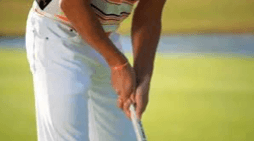
When standing naturally, every golfer has shoulders that are either open (left shoulder behind right), closed (right shoulder behind left) or square. Most golfers have open shoulders, and the putting setup that best accommodates this anatomical structure is one that features a cross-handed (left-hand-low) putting grip style.
Some websites describe how your putting technique should be determined by your anatomical structure. There are a few ways to determine this. The best is to stand in any doorway with your toes set across the carpet seam. Look left, then right. If your left shoulder is farther behind the door jamb than your right, you have open shoulders.
A second test is to get into your putting stance. Allow your hands to hang naturally, then pull your arms together until your hands meet. If your right hand is on your left, again you have open shoulders. To accommodate open shoulders in your setup, use a cross-handed putting grip. With the left hand below the right on the handle, your shoulders will automatically square themselves to the target line, resulting in a straighter putting stroke.
This style takes away both common faults that conventional putting grip styles encounter, with the left hand acting as a deterrent for the right hand to overpower. This grip has become more popular today preventing some of the pitfalls of a conventional grip.
Claw
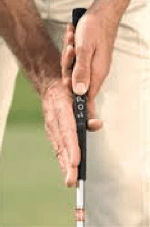
The rule with putting is to do whatever makes the ball find the hole in a manner that can be repeated consistently. There are no rules about sticking primarily to one putting grip style, like using only one type of shot in your long game. Using the grip style that suits the putt might help you have more success.
The Claw grip also takes away two of the common faults seen in a conventional grip. It tends to lock the left wrist in place and controls the right hand from overpowering. The reason behind this is that the right hand is placed underneath the grip between the thumb and index finger. This puts the right hand more on the side of the grip acting in a pushing or brushing motion. With the right hand in this position, it becomes very difficult to twist or turn the putter face producing a more robust and consistent stroke, especially under pressure. There are different styles of claw and the placement of the right hand and of your fingers.
Putter Grip Brands That Can Help
Simply changing the actual grip on your putter shaft can drastically improve your putting as well. I wrote this guide for some of the top companies I recommend (there are tons of them now). A lot of these grips are either oversized or have different shapes than traditional grips. This can accomplish a few goals:
- setting your hands in the right position
- reducing the role of your hands
- preventing the face from twisting
Here are a few companies I highly recommend checking out:
SuperStroke
I'll start with the company that changed things for the better. SuperStroke is certainly the innovator in this category. Their unique design and varying thickness of grips have made them arguably the most popular supplier of putter grips in the world.

Personally, when I switched to their Fatso 5.0 Oversize model years ago it helped alleviate some "yip" tendencies I was having on longer putts.
Their Flatso series is the most popular, which is available in three separate thicknesses. Additionally, they have released a line of counterbalanced grips, which are gaining more popularity as of late.
Overall, they have the most versatile line of putter grips available in my opinion. You can view their complete lineup on their website.
P2 Putter Grips
This company caught my eye at the 2017 PGA Merchandise Show with their innovative designs. I liked them so much I played with their React Tour model last year and wrote this review.

The reason I like P2 Grips so much is that their putter grips set your hands very nicely on the club. Additionally, their unique design gets the shaft of the putter more in line with your forearms, which allows your wrists to lock a little more and resist twisting the clubface open or closed.
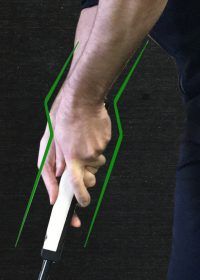
They have continued to innovate their line of grips, and I highly recommend giving them a shot.
Flat Cat Golf
Flat Cat is another putter grip company that took the market by storm a few years ago. You may have seen Justin Rose and a few other PGA Tour players using their grips on TV. Recently they were acquired by Lamkin due to their popularity.
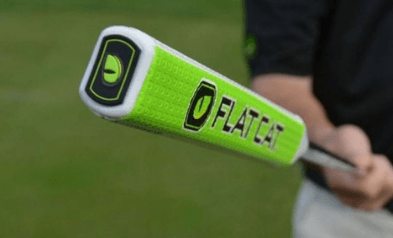
This is another interesting grip which seeks to remove the golfer's hands from their putting stroke. It is a bit more extreme than other designs out there, but plenty of golfers who use them swear by their products.
Posture and Eyeline
One fault of the recreational golfer is that they don't have a consistent setup to the ball when they putt. Sometimes they will hunch over, other times they might stand completely upright. This can greatly affect your putting technique and ultimately prevent success.
While there is no right way to do this, you do want to achieve consistency.
Here are a couple of videos from our Practical Golf Insider Library that can help:
Setting up your eyeline:
Posture setup:
A putting mirror is a great tool to help with posture and eyeline as well. Personally, I use this one from SeeMore Putters. It not only allows you to consistently set your eyes but also your shoulders.

Using The Right Putter
A lot of golfers default to buying putters that look the best (yes I'm talking about Scotty Camerons), but will not spend any time to find out whether or not it's the right putter for their tendencies.
I have learned a lot about club fitting since I started Practical Golf. I can tell you with absolute certainty that getting the right putter in your hands through a fitting can improve your performance.
Overall, you want to get the following specifications properly fit:
- Putter head for your stroke (blade, mallets, etc)
- Weighting (heel or toe biased)
- Lie Angle
- Loft
- Shaft length
You can read this article to find out what a putter fitting can achieve. Your best bet is to locate a club fitter in your area. Some putting manufacturers like Edel and SeeMore have networks of coaches who will fit you properly.
If looks are very important to you, then you can check out my guide to the top custom-putter companies out there.

Recommended Putting Resources
If you want to learn more and practice more effectively here are some resources and products that I recommend.
Putting Books
Unconscious Putting by Dave Stockton
Your Putting Solution by James Sieckmann
Putting Out of Your Mind by Dr. Bob Rotella
Putting Training Aids
I've tested a lot of the top putting training aids out there. Here are a few that I believe can help your game:
Wrapping It Up
I hope you have found this guide useful and it has given you some ideas. We have plenty of other articles on Practical Golf to help with other parts of your game (over 300 at this point!). If you have any questions or feedback be sure to leave a comment below.
Just remember that putting can confound even the best golfers on the planet. Your goal is to give yourself the best chance possible at success but to live with the results. I'll leave you with this quote:
I've heard people say putting is 50 percent technique and 50 percent mental. I really believe it is 50 percent technique and 90 percent positive thinking, see, but that adds up to 140 percent, which is why nobody is 100 percent sure how to putt.- Chi Chi Rodriguez
We care about the protection of your data Read our Privacy Policy